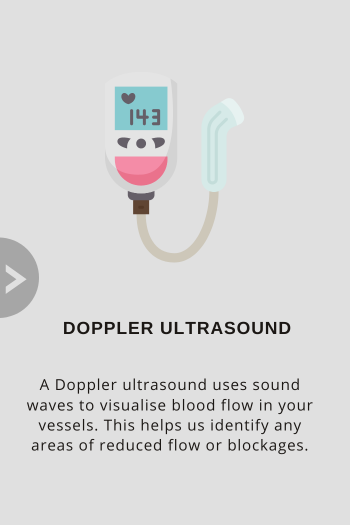
Vascular Assessment.
At Foot Faults Podiatry, we understand the crucial role that healthy blood flow plays in maintaining the overall health of your feet and lower limbs. Vascular assessments are a key part of our comprehensive foot care services, helping us identify and manage conditions related to poor circulation.
Doppler assessment in practice.
What to expect, at your first Vascular Assessment.
FAQs
-
A podiatry vascular assessment is a thorough examination conducted by a podiatrist to evaluate the blood circulation in the lower limbs, specifically in the feet and ankles.
It helps in diagnosing conditions related to poor blood circulation in the lower extremities, such as peripheral arterial disease (PAD) and diabetes-related vascular issues.
-
Individuals with diabetes, smokers, those with a family history of vascular problems, and anyone experiencing symptoms like leg pain, cramping, numbness, cold feet or wounds that are slow to heal should consider getting assessed.
-
It can include a combination of tests such as Doppler ultrasound, measuring toe blood pressures, measuring ankle-brachial index (ABI) and visual inspection to evaluate blood flow and identify any abnormalities.
-
The duration can vary depending on the complexity of the case and the specific tests required, but it usually takes around 30 to 40 minutes.
-
Based on the findings of the assessment, the podiatrist will discuss the results with the patient and recommend appropriate treatment or further investigations if necessary.
-
The frequency of assessments depends on individual risk factors and medical history. Generally, individuals with diabetes or other vascular risk factors will be completed annually but may need assessments more frequently, as advised by their podiatrist.
-
Yes, adopting a healthy lifestyle, managing conditions like diabetes and hypertension, limiting processed foods, quitting smoking, maintaining a healthy weight, and regularly exercising can help prevent or minimize vascular issues in the feet.
-
No referral is needed to book in for a vascular assessment with our Podiatrists.
-
This appointment is eligible for Private Health Fund Rebates. Your rebate amount depends on your level of cover.
Foot Faults is a Preferred Provider for Medibank, Bupa and HCF, which means members enjoy bigger rebates +/- discounted fees on their appointments and services.
-
Most Podiatry appointments are not eligible for Medicare rebates.
If you have an eligible Medicare Referral, it can be used as a part payment.










